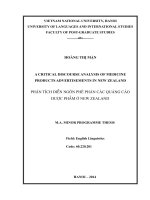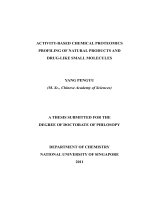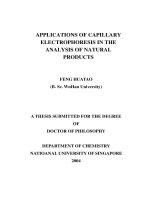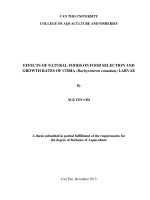Chemistry of calophyllum wallichianum, scapania undulata, plagiochila colorans and biotransformation of natural products
Bạn đang xem bản rút gọn của tài liệu. Xem và tải ngay bản đầy đủ của tài liệu tại đây (730.79 KB, 104 trang )
CHEMISTRY OF CALOPHYLLUM WALLICHIANUM,
SCAPANIA UNDULATA, PLAGIOCHILA COLORANS
AND
BIOTRANSFORMATION OF NATURAL PRODUCTS
HUANG MINGXING
NATIONAL UNIVERSITY OF SINGAPORE
2007
ACKNOWLEDGEMENTS
I would like to express my sincere gratitude and appreciation to my supervisor,
Associate Professor Leslie J. Harrison, for his guidance, patience and encouragement
during the past two years. It will be impossible for me to complete my project without
your invaluable advice and support.
I wish to thank Associate Professor Benito C. Tan in the Department of Biological
Science for his invaluable suggestions. I will also thank Associate Professor Teck K.
Tan in the Department of Biological Science and Associate Professor Eng Soon Tok in
the Department of Physics for every convenience and support they provided.
I also would like to thank my friends, Yanmei, Xiaowei, Li Wei, Chiakwu, who
help me a lot throughout my project.
My appreciation will also give to the technical staff of Department of Chemistry
for NMR, MS and XRD analysis, and Ms Chua Ling Lih for the technical support for
the biological part of my project. I also want to thank National University of
Singapore for financial support and the research scholarship.
Finally but not least, I really want to express my deep gratitude to my dear family
members, my father, my mother, my brothers and my sister. You always stand behind
me and support me. I do want to say thank you to all of you, for your love,
understanding and encouragement.
Contents
Summary
I
List of Tables
III
List of Figures
IV
List of Schemes
V
Chapter 1 General introduction
1
1.1 Introduction
1
1.2 Natural Products
1
1.3 Biosynthesis of Natural Products
9
1.4 Natural Products in Modern Drug Discovery
Chapter 2 Chemistry of Calophyllum wallichianum
12
14
2.1 Introduction
14
2.2 Results and Discussion
17
2.3 Experimental
26
Chapter 3 Chemistry of Scapania undulata
32
3.1 Introduction
32
3.2 Results and Discussion
37
3.3 Experimental
63
Chapter 4 Chemistry of Plagiochila colorans
72
4.1 Introduction
72
4.2 Results and Discussion
74
4.3 Experimental
76
Chapter 5 Biotransformation of Natural Products
78
5.1 Introduction
78
5.2 Results and Discussion
83
5.2.1 Small-scale Screening Experiments
83
5.2.2 Biotransformation of (±)-Camphor by Mucor plumbeus
85
5.2.3 Biotransformation of (±)-Camphor by Aspergillus niger
87
5.3 Experimental
88
References
5.3.1 General Procedure for Biotransformation
88
5.3.2 Biotransformation of (±)-Camphor by Mucor plumbeus
89
5.3.3 Biotransformation of (±)-Camphor by Aspergillus niger
90
93
Summary
This thesis deals with the phytochemistry of one ever green tree and two
liverworts. The isolation and purification were mainly achieved by the combination of
various chromatographic techniques and the structural identifications were mainly
dependent on the employment of spectroscopic techniques including Nuclear
Magnetic Resonance (1D and 2D NMR), Mass Spectrometry, X-ray Diffraction, etc.
Chapter one gives a general background of natural products chemistry. Chapter
two to chapter four concern the chemical studies of three plants: Calophyllum
wallichianum, Scapania undulata and Plagiochila colorans. The last chapter covers
the biotransformation of terpenoids.
Phytochemical studies on Calophyllum wallichianum afforded two novel
coumarins (74 and 75) along with eight known compounds: cordatolide A (63),
cordatolide B (64), 12-O-methylcordatolide B (69), 12-O-methylcalanolide B (70),
trapezifolixanthone (71), pseudocordatolide C (72), carpachromene (73) and
(+)-epiafzelechin (76).
Investigation of Scapania undulata led to the isolation of six novel compounds
(119-124)
together
(-)-ent-longipinanol
with
(84),
five
known
compound
compounds:
110,
(-)-longiborneol
diplophyllolide
A
(78),
(117),
ent-5β-hydroxydiplophyllolide (118). In addition, three compounds (125-127) were
also isolated and there have been many evidences indicating that they were degraded
labdane-type diterpenoids, but their structural identification still requires further
investigation.
The last plant studied was Plagiochila colorans, and this research yielded two
known sesquiterpenoids: peculiaroxide (139) and gymnomitrol (140).
In the studies of terpenoids biotransformation, small scale trial experiments were
developed to screen the fungi that are capable to transform the substrates to be
investigated, and the selected biotransformation of camphor by Mucor plumbeus and
Aspergillus niger afforded three and four mono-hydroxylated products, respectively.
Key words: Natural products, Calophyllum wallichianum, Scapania undulata,
Plagiochila colorans, Biotransformation
List of Tables
Table 2-1. 1H, 13C NMR Data and HMBC Correlations of 74
Table 3-1. 1H, 13C NMR Data of 117 and 1H NMR data of ent-Diplophyllolide A
Table 3-2. 1H, 13C NMR Data and HMBC Correlations of 119
Table 3-3. 1H, 13C NMR Data and HMBC Correlations of 120
Table 3-4. 1H, 13C NMR Data and HMBC Correlations of 121
Table 3-5. 13C NMR Comparison of 122 and Scapanin B
Table 3-6. 1H, 13C NMR Data and HMBC Correlations of 123
Table 3-7. 1H, 13C NMR Data and HMBC Correlations of 124
Table 3-8. 1H, 13C NMR Data and HMBC Correlations of 125
Table 3-9. Comparison of the NMR Data of 120, 125 and 126
Table 3-10. 1H, 13C NMR Data and HMBC Correlations of 126
Table 5-1. GC Data of the Small Scale Trial Experiments
List of Figures
Figure 2-1 Relative stereochemistry of ring D fragment of 63
Figure 2-2 Key HMBC correlations of compound 74
Figure 2-3 ORTEP diagram of compound 75
Figure 3-1 ORTEP diagram of compound 110
Figure 3-2 Octant projection diagrams of compound 104
Figure 3-3 Key HMBC correlations of compound 119
Figure 3-4 ORTEP diagram of compound 119
Figure 3-5 Key HMBC Correlations of compound 120
Figure 3-6 NOESY correlations of compound 120
Figure 3-7 ORTEP diagram of compound 120
Figure 3-8 Key HMBC Correlations of compound 121
Figure 3-9 NOESY correlations of compound 121
Figure 3-10 ORTEP diagram of compound 122
Figure 3-11 Key HMBC correlations of compound 123
Figure 3-12 ORTEP diagram of compound 123
Figure 3-13 Key HMBC Correlations of 124
Figure 3-14 ORTEP diagram of compound 124
Figure 3-15 Key HMBC correlations of compound 125
Figure 3-16 Key HMBC Correlations of compound 126
List of Schemes
Scheme 1-1 Biosynthesis of phloracetophenone (43)
Scheme 1-2 Biosynthesis of alternariol (44)
Scheme 3-1 Chemical transformation of scapanin A (91) to 110
Scheme 5-1 Hydroxylation of α-ionone (141) with Streptomyces strains
Scheme 5-2 Possible metabolic pathway of camphor (157) in the larva of Spodoptera
litura
Scheme 5-3 Scheme of the biotransformation of camphor with Mucor plumbeus
Scheme 5-4 Scheme of the biotransformation of camphor with Aspergillus niger
Chapter 1 General Introduction
1.1 Introduction
There is a very long history of compounds from living organisms such as plants
and animals being utilized by human beings. The employment of these substances in
the treatment of human diseases can be traced back to the Sumerian civilization. In
ancient Egypt, India, China, etc., a large number of plants had been found to work
well to treat some diseases. For example, Ma Huang, or Ephedra spp. (Ephedraceae)
was traditionally used as a diaphoretic, anti-asthmatic and diuretic drug i, and Qian
Ceng Ta, or Huperzia serrata (Huperziaceae) was employed to treat fever and
inflammation ii,iii. In addition, natural occurring compounds have also been used for
thousands of years as dyes (e.g. indigo, shikonin), flavours (e.g. vanillin, capsaicin,
mustard oils), fragrances (e.g. various essential oils), stimulants (e.g. caffeine,
nicotine), hallucinogens (e.g. morphine, cocaine), insecticides (e.g. nicotine, piperine),
and so on.
1.2 Natural Products
Natural products consist of two categories: primary metabolites and secondary
metabolites. Primary metabolites are ubiquitous in living organisms where they play
essential roles in the growth, development and reproduction. Carbohydrates, amino
acids, lipids, nucleic acids and proteins are typical examples of primary metabolites.
Secondary metabolites, however, are chemical compounds that are not strictly
necessary for the survival of organisms. However, they often play some essential roles
from the perspective of ecology. Many metabolites, for example, have been found to
provide defense against predators, parasites and diseases. Common examples of this
category of metabolites include terpenoids, alkaloids, flavonoids, and so forth.
Compared with primary metabolites, the occurrence of secondary metabolites is rather
restricted. However, it is noteworthy that the boundary between primary metabolites
and secondary metabolites is sometimes blurred. For example, some fatty acids and
sugars are extremely rare and found only in several species, and at the same time,
some sterols are found to play essential role for the survival of many organism and
therefore must be considered to be primary metabolites. Currently, the concept of
natural products is widely considered to be secondary metabolites.
Although natural products have been diversely utilized for thousands of years,
their modern and systematic studies did not begin until late eighteenth century. The
development of modern separation methods, such as various analytical techniques and
preparative chromatographic methods made it possible to isolate compounds present
in extremely small quantities, whilst the development of spectroscopic techniques
such as UV, NMR, MS, CD, etc, leads to the rapid structural elucidation even with
trace quantity iv.
Natural products do not directly relate to the survival of creatures, their crucial
roles in the evolutionary and ecological perspectives, however, have been widely
recognized for a long time. In plant kingdom, some natural products serve as
attractants to ensure pollination and reproduction, some act to warn and defend
against herbivores and some other compounds play significant role in the competition
with surrounding plants for light, space and nutrients. At the same time, secondary
metabolites are also frequently employed by various animals to communicate, defend
and hunt.
Some secondary metabolites contribute to the color of flowers, which is a
significant means to attract pollinators. At the same time, the blend of different classes
of volatile secondary metabolites (mainly monoterpenoids) in plants produces a broad
spectrum of scents to behave as attractants. For example, Nicotiana otophora use
volatile and fragrant compounds such as α-thujene (1), myrcene (2), limonene (3),
1,8-cineole (4), sabinene (5), etc. to attract pollinating insects, whereas apple
(Malus×domestica) uses 2-phenethyl alcohol (6), linalool (7), cis-3-hexenyl acetate (8)
and other compounds for the same purpose v.
O
(1) α-thujene
(2) myrcene
(3) limonene
(4) 1,8-cineole
OH
OH
O
O
(5) sabinene
(6) 2-phenethyl alcohol
(7) linalool
(8) cis-3-hexenyl acetate
On the other hand, many secondary metabolites in plants play essential roles in
deterring herbivores due to their bitter or pungent taste. For example, quinine (9),
strychnine (10), brucine (11), emetine (12) and sparteine (13) have bitter taste, whilst
capsaicin (14) and piperine (15) are pungent alkaloids vi.
H
N
N
HO
R1
H
H3CO
R2
N
O
H
O
N
(9) quinine
(10) strychnine: R1 = R2 = H;
(11) brucine: R1 = R2 = OCH3
H3CO
N
H3CO
H
H
N
H
N
H
H
OCH3
HN
OCH3
(12) emetine
(13) sparteine
H3CO
HO
O
HN
N
O
O
O
(14) capsaicin
(15) piperine
However, it should be noted that the taste properties are sometimes not identical
for all animals, e.g. some smelly compounds such as 2-thioethanol are strong
repellents for humans, but food containing such compounds often attracts geese vii.
Furthermore, some secondary metabolites of plants display extreme toxicity,
which protects the hosts against the herbivores. For example, Delphinium consolida
(Ranunculaceae) contains diterpene alkaloids such as delphinine (16), delcosine (17)
and delsoline (18) that are very toxic to animals.
R6
R2
OCH3
R1
R5
N
R4
R3
OCH3
OCH3
(16) delphinine: R1 = OCH3, R2 = CH3, R3 = H, R4 = COOCH3, R5 = OCOC6H5, R6 = OH;
(17) delcosine: R1 = OH, R2 = CH2CH3, R3 = OH, R4 = OH, R5 = OH, R6 = H;
(18) delsoline: R1 = OH, R2 = CH2CH3, R3 = OH, R4 = OH, R5 = OCH3, R6 = H.
In addition to defending against herbivores, plants also have to compete with
surrounding plants to acquire more light, water, space and nutrients, and this
competition is termed as allelopathy. A range of secondary metabolites including
phenolic acids, glucosinolates, terpenoids, flavonoids and alkaloids have allelopathic
activity and these metabolites are capable to inhibit the germination or growth of
other plants to ensure the advantageous position of the hosts in the competition. For
example, vinblastine (19) and yohumbine (20) from Catharanthus roseus
(Apocynaceae) are able to cause temporary abnormalities in cell division of
neighboring Vicia faba viii. Other compounds that also exhibit allelopathic activities
include cocaine (21) from Erythroxylum coca, strychnine (10) from Strychnos
nux-vomica, physostigmine (22) from Physostigma venenosum ix and caffeine (23),
theobromine (24) and theophylline (25) from Coffea arabica x.
H
OH
N
N
C2H5
N
OH
H
H
NH
N
H
H
COOCH3
C2H5
COOCH3
H3CO
N
CH3
OCOCh3
H
HO
COOCH3
(19) vinblastine
(20) yohimbine
CH3
O
N
H
CH3
N
O
N
O
H3C
H3COOC
H
N
O
CH3
(21) cocaine
O
H3C
O
CH3
N
CH3
(23) caffeine
N
CH3
N
N
N
O
(22) physostigmine
HN
O
O
H
N
H3C
N
N
N
CH3
(24) theobromine
O
N
N
CH3
(25) theophylline
The employment of secondary metabolites by animals is rather frequent as well.
Some insects are able to excrete bitter tasty alkaloids through a reflex bleeding
mechanism when they are attacked by predators. For example, coccinellid beetles
synthesize many types of defensive alkaloids. The most typical alkaloids include
precoccinelline (26) from Coccinella septempunctata, hippodamine (27) from
Hippodamia convergens, myrrhine (28) from Myrrha octodecimguttata, propyleine
(29) from Propylaea quatuordecimpunctata xi and chilocorine A (30) from Chilocorus
cacti xii.
H
H
H
N
N
N
H
H
H
H
CH3
H
CH3
(26) precoccinelline
H
CH3
(27) hippodamine
(28) myrrhine
H
H
O
N
N
H
N
H
CH3
CH3
(29) propyleine
(30) chilocorine A
In addition, many amphibians such as frogs and toads have been found to
produce poisonous substances in their skin secretions for protection against microbial
infections and natural predators. For example, five species of Phyllobates
(Dendrobatid frogs) are able to excrete rather toxic batrachotoxins such as
batrachotoxinin A (31) and batrachotoxin (32) xiii.
H3C H3C
N
H
OR
(31) batrachotoxinin A: R = H;
HO
O
CH3
(32) batrachotoxin: R =
O
C
O
H3C
HO
H
CH3
N
H
On the other hand, many secondary metabolites are widely employed by
animals such as ants and insects for communication with other members. Chemicals
that are released by an organism for transmission of a message to other members of
the same species are normally regarded as pheromones. The roles are not identical for
different pheromones. Some serve as alarm pheromones, and some other may serve as
trail pheromones or sex pheromones, etc. For example, Myrmicine ants,
Pristomyrmex pungens excrete 6-n-pentyl-2-pyrone (33) from the poison gland to
mark their paths, and some other monoterpenoids released such as α-pinene (34),
camphene (35), α-phellandrene (36), and α-terpinene (37) were found to slightly
increase the trail-following response of this species of ants xiv.
O
O
(33) 6-n-pentyl-2-pyrone
(35) camphene
(36) α-phellandrene
(34) α-pinene
(37) α-terpinene
Sex pheromones are often volatile, and sometimes the pheromones released by
the female can be detected by its potential mate from as far away as 10 km. Examples
of characteristic sex pheromones include anabaseine (38) and anabasine (39) from
Messor ants, Messor capensis and skatole (40) in Pheidole ants, Pheidole fallax xv.
N
H
N
N
H
N
N
(38) anabaseine
(39) anabasine
(40) skatole
In addition, secondary metabolites are also used by animals including spiders,
snakes, lizards, and so on, for hunting. For example, many neuroactive
acylpolyamines have been discovered in the venom of a few spiders. For example,
NSTX-3 (41) and CNS 2013 (42) were discovered in Nephila clavata xvi and
Dolomedes okefinokensis xvii, respectively. Most spider acylpolyamines are believed to
function by blocking glutamate-sensitive calcium channels, but the exact mechanism
remains under investigation.
O
O
H
N
H
N
N
H
N
H
NH2
N
H
O
HO
CONH2
(41) NSTX-3
H
N
H
N
H
N
H
N
O
HO
(42) CNS 2013
1.3 Biosynthesis of Natural Products
There are a huge number of natural products in nature, and they differ greatly in
terms of their structures, characteristics and functions in living creatures. However,
NH2
the number of building blocks required to biosynthesize these metabolites are
surprisingly few. Acetate pathways, shikimate pathways, mevalonate pathways and
deoxyxylulose phosphate pathways cover the biosynthesis of most of the secondary
metabolites we encounter, and the building blocks of these pathways are acetyl
coenzyme A (acetyl-CoA), shikimic acid, mevalonic acid and 1-deoxyxylulose
5-phosphate, respectively. In other words, most of secondary metabolites including
terpenoids, alkaloids, phenols, etc. are all based on these four compounds. The acetate
pathway leads to the formation of phenols, prostaglandins, macrolide antibiotics as
well as various fatty acids and their derivatives at the primary and secondary
metabolism interface. The shikimate pathway produces many phenols, cinnamic acid
derivatives, lignans and alkaloids, whilst the mevalonate and deoxyxylulose
phosphate pathways in combination afford a large number of terpenoid and steroid
metabolites1.
In most cases, the biological reactions involve coenzyme A esters such as
acetyl-CoA,which forms part of a long alkyl chain as in a fatty acid or may be part of
an aromatic system such as phenols. Fatty acids are a large group of secondary
metabolites that could be found in almost all plants. The fatty acid biosynthesis first
of all involves the initial conversion of acetyl-CoA into malonyl-CoA, a reaction
involving ATP, CO2 and the coenzyme biotin as the carrier of CO2. The conversion of
acetyl-CoA into malonyl-CoA increases the acidity of the α-hydrogens, and therefore
provides a better nucleophile for the following Claisen condensation. The successive
incorporation of malonyl-CoA together with the following reduction will lead to the
extension of the chain length by two carbons (C2 unit) for each cycle, until the
required chain length is obtained. For example, the combination of one acetate starter
unit with seven malonates would give the C16 fatty acid, palmitic acid
[CH3(CH2)7COOH].
However, in fatty acid biosynthesis, if reduction after each condensation step
does not happen, the formed poly-β-keto ester may undergo cyclization to form
aromatic compounds. For example, one acetate starter group and three malonate chain
extension units (C2 unit) could form a C8 polyketo ester, and a following Claisen
reaction and enolization will convert this intermediate into phloracetophenone (43).
Likewise, alternariol (44), a metabolite from the mould Alternaria tenuis, can be
established to be derived from a single C14 polyketide chain which is formed from
seven C2 units.
O
O
SCoA
SCoA
+3
O
O
malonyl-CoA
acetyl-CoA
O
O
SEnz
OH
O
O
enolization
O
HO
O
OH
(43) phloracetophenone
Scheme 1-1 Biosynthesis of phloracetophenone (43)
O
7 H3C
CO2H
O
O
O
OH
OH
O
HO
OO
O
O
SEnz
(44) alternariol
Scheme 1-2 Biosynthesis of alternariol (44)
In contrast to the extension of C2 unit as stated in the above cases, the terpenoids
are derived from C5 isoprene units, but the isoprene units really employed in the
biosynthesis are dimethylallyl diphosphate (DMAPP) (45) and isopenetenyl
diphosphate (IPP) (46). The combination of DMAPP and IPP yields geranyl
diphosphate (GPP) (47), and further extension of C5 unit leads to the formation of
farnesyl diphosphate (FPP) (48), geranylgeranyl diphosphate (GGPP) (49), etc. GPP,
FPP and GGPP are precursors of monoterpenoids (C10), sesquiterpenoids (C15) and
diterpenoids (C20), respectively. There are relatively few acylic compounds such as
farnesol (50), geranylgeraniol (51), etc., being derived from only the simple
condensation of these C5 units. However, in most cases, these diphosphates precursors
will undergo other reactions such as cyclization reactions to finally form the various
structurally different terpenoids.
OPP
OPP
(45) DMAPP
(46) IPP
OPP
(47) GPP
OPP
(48) FPP
OPP
(49) GGPP
OH
(50) farnesol
OH
(51) geranylgeraniol
1.4 Natural Products in Modern Drug Discovery
The potent applications of natural products in medicine and pharmacy have drawn
people’s interest for a long time. With the development of isolation and structural
identification techniques, it became possible to recognize which constituent accounts
for a specific biological property, and this greatly accelerated the procedure of drug
discovery. Natural products traditionally have played an important role in drug
discovery, but the improvement of alternative drug discovery methods such as rational
drug design and combinatorial chemistry to some extent threatened natural products
drug discovery. However, natural products are still an essential part in drug discovery
because they are able to provide a broad array of lead compounds, which is the basis
of modern drug discovery. It was reported that at least 21 natural products and natural
product-derived drugs have been launched onto the market in the United States,
Europe or Japan from 1998 to 2004 xviii. For example, lobeline (52), an alkaloid from
Lobelia inflate, is the active constituent of anti-smoking products such as Cig-Ridettes
and Citotal, as well as of preparations against bronchial asthma, chronic bronchitis,
cough, vascular disorders and insomnia. In addition, byrostatin-1 (53), a natural
product that was discovered from Bugula neritina (Bryozoan), is a protein kinase C
(PKC) and it has been granted Orphan Drug status by the FDA and designated an
Orphan Medicinal Product in Europe for oesophageal cancer xix.
H
OH
H3CO
O
O
O
O
OH
H
H
OH
O
OH
OH
O
N
HO
O
H
CH3
O
HO
OCH3
O
OH
(52) lobeline
(53) byrostatin-1
H
Chapter 2 Chemistry of Calophyllum wallichianum
2.1 Introduction
Calophyllum is a plant genus of tropical evergreen trees in the family Clusiaceae
with approximately 200 species. The distribution of this genus of trees is rather wide,
and they are found in Madagascar, eastern Africa, South and Southeast Asia, the
Pacific islands, and the West Indies as well as South America. Their growth
environments vary greatly as well, and a large number of habitats including ridges in
mountain forests, coastal swamps, lowland forest and coral cays are suitable for the
growth and production of this genus.
In terms of the phytochemistry, Calophyllum is a rich source of aromatic
compounds. A wide spectrum of xanthone and coumarin derivatives have been
reported from this genus, and many coumarin derivatives display anti-HIV activities
which imply their potential application for treating HIV xx. Research on C. inophyllum
afforded a series of inophyllum type pyranocoumarins such as soulattrolide (54),
inophyllum G-1 (55), inophyllum G-2 (56) and inophyllum P (57). Similar studies on
C. lanigerrum led to the discovery of a series of calanolide type pyranocoumarins
such as calanolide A (58), calanolide E (59), calanolide E2 (60), calanolide F (61), and
calanone (62), and the research of C. cordato-oblongum yielded a series of
cordatolide type pyranocoumarins including cordatolide A (63), cordatolide B (64)
and oblongulide (65) as well as xanthones such as cordato-oblonguxanthone (66),
jacareubin (67) and scriblitifolic acid (68) xxi.
O
O
O
O
O
O
O
O
OH
OH
(54) soulattrolide
(55) inophyllum G-1
O
O
O
O
O
O
O
O
OH
OH
(56) inophyllum G-2
(57) inophyllum P
O
O
HO
O
O
O
O
O
O
OH
HO
(58)
calanolide A
(59) calanolide E (enantiomer of 60)
(60) calanolide E2
O
O
O
O
O
HO
O
O
O
OH
(61) calanolide F
(62) calanone
O
O
O
O
O
O
O
OH
O
OH
(63) cordatolide A
(64) cordatolide B
O
O
O
H3CO
O
O
O
O
OH
(65) oblongulide
(66) cordato-oblonguxanthone









